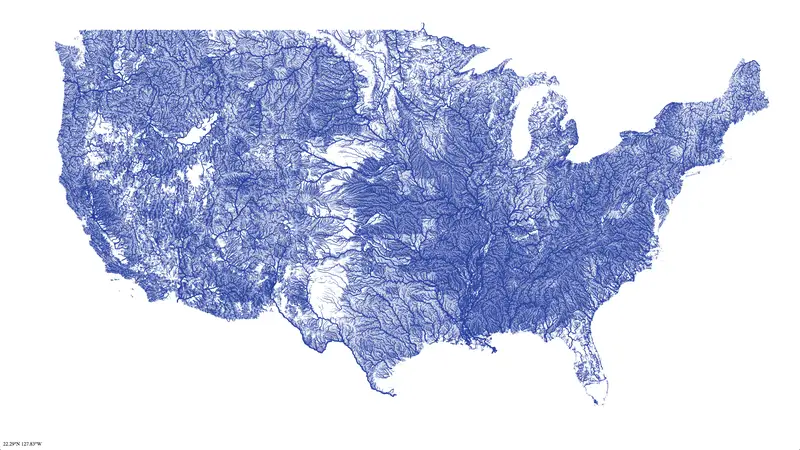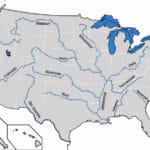Get ready to be amazed by Alaska’s incredible network of rivers! With over 12,000 documented rivers, Alaska is undeniably the king of waterways in the United States. But these rivers aren’t just static lines on a map; they’re dynamic, living ecosystems teeming with life, offering endless adventures for those drawn to their banks. Let’s dive in and discover what makes Alaska’s rivers so special!
The State with Most Rivers: Alaska, Where Water Reigns Supreme
Curious about which state in the U.S. boasts the most rivers? Look no further than the Last Frontier – Alaska! This incredible state is a true watery wonderland, home to more rivers than any other, with over 12,000 gracing its diverse landscapes. When considering the total area covered by water, Alaska again takes the crown, solidifying its reputation as a place where rivers truly rule.
But it’s not just about quantity; Alaskan rivers are impressive in scale. Consider this: over 3,000 of these rivers stretch over 50 miles long! These flowing arteries carve their way through some of the most breathtaking scenery imaginable, winding past towering mountains, cutting through dense forests, and meandering across the vast tundra. They act as the veins of Alaska, connecting its diverse landscapes and breathing life into the surrounding ecosystems.
Now, you might picture Alaska as one giant swamp with all this water. Surprisingly, while rivers are undeniably abundant, they only cover approximately 14.2% of the state’s total land area, less than one-sixth! This fascinating fact highlights just how massive and geographically diverse Alaska truly is.
The Yukon River, Alaska’s longest river, is a true icon of the state. Then there’s the Kuskokwim River, known for its winding path and the sheer abundance of fish that call it home. These rivers aren’t just pretty to look at; they play a crucial role in the lives of Alaskans. They act as vital transportation routes, connecting communities and allowing for trade and travel. Plus, they support a rich diversity of aquatic life, making them essential to the state’s ecosystem.
Alaska, the state with the most rivers, is a place of incredible natural beauty and wonder. It’s a testament to the power of water and a reminder that even in the most remote corners of the world, rivers connect us all.
Which State Reigns Supreme – Unveiling the State with the Most Rivers
Alaska’s wilderness is truly one-of-a-kind, and a major contributor to this distinction is its abundance of rivers. Imagine this: Alaska boasts a staggering 3,197 rivers that stretch over 50 miles long! That’s longer than countless marathons laid end-to-end!
And the star of the show? That has to be the mighty Yukon River. Flowing for over 1,900 miles, This river is like the main artery of Alaska, snaking its way across the state. Imagine taking a boat trip down that – talk about an adventure! But the Yukon isn’t the only celebrity in town. Alaska boasts a whole cast of stunning rivers, each with its own unique personality. Take the Kuskokwim River, for example. This beauty is known for its winding path and stunning scenery.
Now, you might think that with all these rivers, Alaska must be drowning in water, right? Well, not quite. While it definitely takes the crown for river quantity, only about 14.2% of Alaska is actually covered in water. That’s more like a healthy dose of H2O, not a complete submersion. Compare that to some of the drier states in the Midwest and West, where water coverage can dip below 1%, and you start to see just how special Alaska’s water wonderland really is.
What’s even cooler is that Alaska’s rivers aren’t just there to look pretty (though they do a pretty great job of that, too!). They’re teeming with life! Think schools of salmon, playful otters, majestic bald eagles soaring overhead… these rivers are like the lifeblood of Alaska’s ecosystem. Some scientists even believe that the sheer number and diversity of Alaska’s rivers could hold secrets to understanding how ecosystems thrive. They’re constantly studying these waterways to learn more about the delicate balance of nature.
Alaska, the undisputed champion of rivers, holds a special place in the heart of America’s landscape. It’s a land where adventure flows freely and the call of the wild echoes from every riverbank.
Why Are Rivers So Important – Understanding Their Significance
Rivers are more than just water flowing through a landscape. They’re like the veins and arteries of our planet, pumping life into everything they touch. We’ve already talked about how crucial they are, but let’s really dive into why these flowing waters are so vital.
Think about it – when you’re thirsty, what do you reach for? A nice, refreshing glass of water, right? Well, rivers are where a lot of that water comes from. They act like giant filters, naturally cleaning rainwater and providing a significant chunk of the fresh water we use every day, not just for drinking but for growing our food and keeping our homes running too. Without them, many areas would be much drier and less hospitable.
But it’s not just us who depend on rivers. Imagine a bustling city – that’s what a healthy river is like. It’s teeming with life! Fish, turtles, frogs, insects – they all call rivers home. The riverbanks themselves are like green ribbons of life, providing food and shelter for animals living both in and out of the water. And because everything in nature is connected, when rivers are healthy, the whole ecosystem thrives, from the tiniest bug to the largest predator.
Throughout history, humans have always been drawn to rivers. It’s no coincidence that many ancient civilizations sprung up along riverbanks. Rivers were our first highways, making it possible to trade, travel, and connect with other communities. The fertile land surrounding rivers also made it possible to grow crops and settle down, shaping the course of human history. Even today, think about how many cities are located on rivers! They provide us with resources, recreation, and even inspiration for art and culture.
Let’s break it down a bit further, shall we?
Rivers: The Ultimate Multitaskers
| Importance | What It Means |
|---|---|
| Life Support System | They provide fresh water for drinking, agriculture, and industry, sustaining life as we know it. |
| Biodiversity Hotspots | They are home to a vast array of plants and animals, many of which are found nowhere else. |
| Transportation Corridors | They act as natural highways, allowing for movement of people and goods. |
| Economic Powerhouses | They support industries like fishing, tourism, and transportation, contributing to economies. |
| Cultural Cornerstones | They inspire art, music, literature, and spiritual practices, enriching human culture. |
The Future of Rivers
While we know a lot about rivers, there’s still so much more to learn. Scientists are constantly studying how rivers function, how they are affected by pollution and climate change, and how we can better protect them. It’s an ongoing conversation, and everyone has a role to play in ensuring these vital waterways remain healthy for generations to come.
Beyond the Numbers – Exploring the Diverse River Systems Across the US
Let’s delve deeper into the amazing world of American rivers. We’ve already touched upon how many rivers flow through our nation, but it’s Alaska that really steals the show. Think about it – towering mountains, massive glaciers, and a coastline that seems to go on forever. It’s the perfect recipe for a whole lot of rivers! And that’s exactly what we find in Alaska, a state practically bursting at the seams with over 3,000 rivers stretching over 50 miles long!
Now, these aren’t just any rivers. They wind their way through some of the most stunning scenery you can imagine. Picture snow-capped peaks reflected in crystal-clear water, dense forests teeming with life, and vast, open tundra where the rivers seem to flow into forever. Each twist and turn of these Alaskan waterways reveals something new and breathtaking.
Of course, every river has its own story to tell. Take the mighty Yukon River, for instance. Clocking in at over 1,979 miles long, it holds the title of Alaska’s longest river. Then there’s the Kuskokwim River, meandering through western Alaska and renowned for its abundance of fish and breathtaking beauty. These aren’t just pretty faces, though. These rivers are the lifeblood of the ecosystem, providing drinking water, sustaining diverse habitats, and offering fantastic opportunities for fishing and exploring the great outdoors. To learn more about the longest river in Alaska, check out our page here.
But the story of America’s rivers doesn’t end in Alaska. Down in the southwest, the Colorado River snakes its way through the arid landscape, a lifeline for states like California. And let’s not forget the mighty Mississippi, the granddaddy of them all, flowing through the heartland of America and supporting a mind-boggling array of plants and animals along the way. It’s a river that’s woven into the very fabric of American culture and history. To know about the largest rivers in the United States, read our article here. To learn more about the longest river of Mexico, visit our article here.
Key Takeaways:
- Alaska takes the crown for the most rivers, with over 3,000 flowing over 50 miles long, thanks to its unique geography and climate.
- From mountains to forests to wide-open tundra, Alaska’s rivers support a whole world of plants and animals.
- Rivers are essential – they provide drinking water, help with irrigation, and offer ways to travel, trade, and enjoy the outdoors.
- The Yukon River is Alaska’s longest, while the Kuskokwim River is known for its abundant fish populations and stunning scenery.
- Other states like California, with its Colorado River, and the Midwest, home to the Mississippi River, show just how diverse America’s river systems truly are.
- Discover Long Black Pepper: Flavor & Health Benefits - April 25, 2025
- Shocking Twists: The Grownup Review: Unreliable Narration - April 25, 2025
- A Quiet Place Book vs Movie: A Deep Dive - April 25, 2025
















